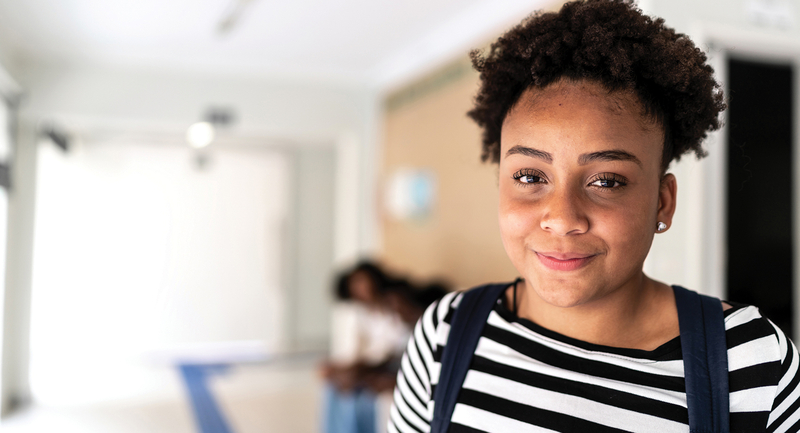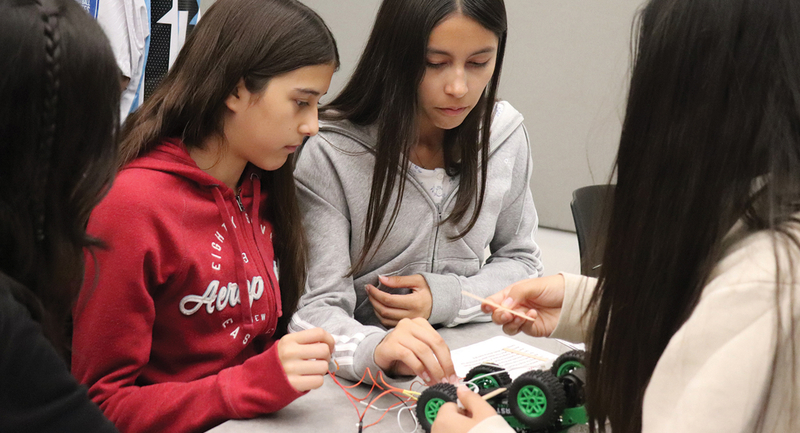In the Summer of 2020, the two of us heard Terry Harris, a school administrator in Rockwood, Missouri, speak as part of a graduate course. Harris asserts that all societal decisions should focus on children's well-being. We were especially moved by his words about making schools safer places for students of color, who are too often singled out, misjudged, or disrespected. Referencing the dying words of George Floyd, "I can't breathe," Harris spoke of how students from groups often marginalized in education systems may struggle, feeling they "can't breathe"—such as when a Black student sees a cafeteria worker eyeing him to be sure he doesn't steal something, or when a Latina girl walks into her first Advanced Placement class and realizes no one else in the class shares her ethnic background.
After hearing Dr. Harris and talking with him afterwards, we and several colleagues decided to forge a new focus at Arundel High School in Gambrills, Maryland, where we worked at the time: to do better at serving our students of color and other students who differ from the mainstream. The demographics of Arundel High School had recently changed, as has happened at many public schools. What was a large, predominantly white, middle-class student body had become much more diverse, with white students now making up only forty-five percent of the students from all socioeconomic backgrounds. Our goal was to ensure that all our students, with a particular emphasis on our students of color, felt valued in our school.
Our journey in pursuit of that goal was led by students themselves.
Starting with Student Insight
As a first step, in 2020, the two of us, along with two other lead staff members, asked several Black students at Arundel High whose leadership skills we admired to tell us about their experiences at the school. These students told us that in general the school had a positive culture. But when we shared Dr. Harris's "can't breathe" metaphor, they opened up about times when they'd been made aware of their race in a negative way at school. It was hard to hear the students acknowledge microaggressions, such as repeatedly being mistaken for the only other African American girl in a class. Worse was when one student said with sincerity, "But we know that's just the way it is." We realized we needed to expand their thinking and show them that a community free from microaggressions and negative stereotypes was possible and within our reach.
We knew this effort would require insight that only students could provide and that we needed a forum where students could speak openly to faculty about their school experiences.
Hearing the students' experiences of feeling unsupported at Arundel made it clear there was work to do. Those of us who saw this need for equity-related work chose to partner with students to begin the effort. We felt this was the best course because we sensed that many students were ready to forge a school culture that promoted social justice and prioritized equitable school policies. We also knew this effort would require insight that only students could provide and that we needed a forum where students could speak openly to faculty about their school experiences.
This thinking led to the fall 2020 founding of Arundel High's Equity Leadership Council (ELC), a student-led group that was designed to help uncover and change inequitable school practices or conditions.
The ELC started with the three students we had originally spoken to, but as we spread the word and opened attendance to everyone, participation quickly grew. Here are some key steps we took, and insights we gained, in the three-year journey of this effort.
In fall of 2020, the two of us and several other school adults asked students who had expressed interest in equity issues at Arundel to spend lunchtime once a week conversing with us. The students were excited to have access to the principal for important social justice conversations. Administrators and teacher facilitators at the meetings shared that our goal was to improve our school for everyone, but to focus on our historically marginalized students who have, at times, felt "othered" and not fully embraced in their school. Initial meetings strongly connected the core group of about 15 student leaders to the adult supporters of the ELC.
This group participating in these weekly meetings (held as Google Meets during the pandemic when the school was operating remotely), eventually swelled to around 30 students of different races and grade levels, each of whom had ideas about how to make the school more inclusive. Each meeting, led by a student leader, began with a brief description of an equity-related issue; then the group would problem solve, focusing on culture and practices at Arundel High. As more students began to hear that there was a group advising the principal on equity issues, members of the school's LGTBQ+ community began attending. Not only did students devote many lunchtimes to these conversations, but by winter of 2021, a range of 8 to 15 teachers and other adults from the school community often came as well. By March, students and educators from other schools sometimes joined via video call to see and hear the powerful dialogue being led by our students.
The group of six students who had at first emerged as core leaders of the discussion sessions ultimately became the ELC e-board. This group met weekly with adult sponsors to select topics for the broader gatherings. Besides choosing topics they believed would benefit the school community, the students on the ELC e-board brought up their own equity-related topics they wanted to explore. These topics ranged from cultural appropriation to problems with school services that disproportionally affected certain groups to LGBTQIA+ awareness—and more.
For example, one student shared that his bus often didn't come into his neighborhood. He would walk the two miles to school, arrive late, and receive the consequence of a lunch detention for missing the start of school. He should have been rewarded for getting to school without transportation, but the school's policy on tardiness punished everyone the same, regardless of their reasons for being late.
Although participants' perspectives weren't always aligned, the dialogue was consistently respectful. We believe this tone was because of the capacity-building we fostered in our students as we collaborated with them. The talk was also solution-oriented. After the young man shared about his transportation issues, for instance, administrators began to ask tardy students why they were late so they could address the root cause of any issues instead of just giving a consequence.
Stage 2: Empowering Student Leadership
In the initial weeks of ELC, we realized that empowering students would require skill development. While these teens came to us with a commendable measure of confidence and passion, we sensed that establishing courageous spaces for antiracist and anti-bias action would require us as school leaders to build our student leaders' capacity—so they, in turn, could build the capacity of their peers to make the work accessible for all.
We took several strategic steps to help the students on the ELC e-board gain skills to shape (and lead) a safe space for discussions on equity. We did a close reading of the 4 Agreements of Courageous Conversations by Glen Singleton (Corwin, 2008) with the student leaders, then asked them which expectations would work best for their meetings and dialogues. We collaborated to create the community agreements that would guide ELC throughout the school year, which included being open, honest, and respectful, and accepting non-closure on nuanced systemic issues.
Adult and student leaders also took time to develop shared language and understandings to ensure participants had a clear knowledge of key concepts such as antiracism, anti-bias, and social justice. We discussed the concept of intent vs. impact—the contrast between a person or system's intention and the impact that their actions ultimately have on marginalized people. We practiced strategies for interrupting bias-motivated behavior like "interrupt, question, educate, echo"—a response protocol created by Learning for Justice and developed an understanding of the Calling Out and Calling In approach (Haslam, 2019). This approach involves "calling out" racist, ableist, homophobic, etc., behavior while respectfully "calling in"—educating and coaching—the person who engaged in the problem behavior. Our young scholars mastered these critical concepts and applied them to creating a vision, mission, and goals for the ELC. They worded that mission as "identifying and proposing solutions for inequities in school policies and procedures; increasing cultural responsiveness in curriculum and instruction; and expanding community awareness of social justice issues."
Adults didn't view these students as novices needing to be molded by expert educators to succeed. We treated them as the experts.
One key to our success with the ELC was that we adults didn't view these students as novices needing to be molded by expert educators to succeed. We treated them as the experts (who has more expertise in the student experience than students?) who could strengthen their impact with the knowledge we offered. In response, they took ownership over their organizational goals and their impact.
Stage 3: Building Trust Through Listening and Acting
As the ELC student leaders began to use the skills they developed to facilitate weekly conversations, we realized that once you hear your students' truth, you can never unhear it. For example, one student recounted feeling disconnected from the literature choices in their English classes, citing a lack of representation of BIPOC characters and particularly a typecast of Black oppression being centered in the limited diverse texts offered to students. The student emphasized that they didn't need to see Black oppression or even Black heroism highlighted in text choices. They wanted access to stories about people living an authentic human experience who just happen to be people of color.
Upon hearing this perspective, school administrators and teacher leaders established a literature-selection taskforce, collaboratively led by students and staff, that would prioritize curating diverse, authentic text options for English and Global and Community Citizenship courses. When the district heard about this effort, the students were invited to sit on committees that review curriculum and select texts for the school system.
Because of this swift policy change we made to address an inequity one student identified, the young people in the ELC meetings learned the power of their voice. Truly listening to understand student experiences without judgment laid a foundation of trust, and when adults acted quickly based on what students shared, this secured that trust.
We educators repeated this cycle of listening, acting, and serving as the sessions continued. In one meeting, students shared that when community or world events impact them emotionally because victims of an injustice share their background or race, it's important that school adults acknowledge their feelings instead of simply teaching content as usual. Teacher silence and failure to recognize these issues made students feel unimportant and erased. In response, we worked with the ELC to initiate quick student/teacher check-ins that teachers could conduct with individual kids or as an opening class activity. While these check-ins were optional, once teachers realized how important touching base with students regarding current events was to maintaining impactful relationships, most made them part of their routine.
The leadership council also sought to emphasize the importance of using students' chosen pronouns and asked teachers to let students introduce themselves at the beginning of each semester to avoid a teacher or peer mispronouncing their name or using the wrong pronoun. In response to concerns voiced in several of the weekly discussions, the Council made adults at Arundel aware of the challenges transgender, non-binary, and gender non-conforming students experienced in the school's locker rooms. Our physical education department subsequently developed procedures to make everyone more comfortable.
Stage 4: Centering Students' Voices in PD
As students told us their stories, we realized that hearing their voices was a privilege we should share with all faculty and staff to build their capacity for understanding and educating students from marginalized backgrounds. With the students' permission, we began to videorecord weekly lunchtime discussions, then incorporated that footage into a series of staff development sessions.
In the videos, students responded to questions like, "What do teachers do to make you feel welcome in their classroom?" "When are you made to feel you don't belong?" and "How should teachers respond when they are called out for using microaggressions?" Our predominantly white faculty could finally hear the perspectives of students of color directly from the source, internalize what the teens were saying, and reflect on changes they might make to their instructional and relational approaches.
These PD sessions were helpful for our staff because our approach prioritized educators putting in hard work, taking risks, and making mistakes. Our goal was progress toward equity over perfection. As we helped staff members internalize the idea that "what you permit, you promote; what you condone, you own" by identifying behaviors in school that can keep students from feeling included and valued, we also invited them to free themselves of the weight of shame or burden of perfection. We asked educators to check, reflect on, and correct any implicit biases, which sometimes meant apologizing to students for inappropriate remarks made or allowed in the classroom. Our educators also learned how to "disrupt with dignity"—to denounce unwanted, hurtful behavior, yet acknowledge the humanity of the person behind that behavior. We normalized mistakes as a part of the ongoing antiracist journey, referencing the work of Kendi (2019), and we encouraged colleagues to identify racist behaviors in our community instead of focusing on or labeling racist people.
To navigate these challenging times, educators don't need perfection—we need openness. Our hope in these sessions was to build a community that understood that openness to mistakes is how we learn, openness to discomfort is how we change, and openness to feedback—on any topic, from racism to instruction—is how we respect others' humanity while acknowledging our own.
Stage 5: Taking the Show on the Road
As our work continued, we wanted to share the gift of the ELC experience with people beyond our school, since we knew we had something special. The students also felt a responsibility to bring the broader community into their work—so they did.
As students began inviting friends from other schools in our district to meetings, the discussions began to reflect the intersecting identities of all who joined the community, and the equity and social justice focus of the ELC spread authentically. We as educational leaders also began strategically inviting members of our school district community, including our superintendent and members of our school board, executive team, and the district's office of equity. We also invited principals, administrators, teachers, student groups from other schools, and community leaders, such as the outreach coordinators of county libraries and police officers.
Not only were courageous conversations constantly unfolding in our school, but our students were becoming architects of social justice in their community.
Not only were courageous conversations constantly unfolding in our school, but our students were becoming architects of social justice in their community, reflecting their growing leadership aptitude. When members of the ELC saw an op-ed in the local Capital Gazette newspaper that claimed social justice education was "poisoning" our district's schools, they used a professional protocol to analyze the article, then responded with an op-ed of their own. The students' op-ed was published as a letter to the editor. It informed a large readership that "equity is not [solely] equalizing outcomes, equity is equalizing opportunity" (Capital Gazette Letters, 2021).
Several students also wrote and published another piece in The Capital Gazette about the correlation between providing young people "social justice education" and the potential for establishing a more aware, empathetic, and responsible generation (Hector et al., 2021). Our students had found their voice. Some of them began to work with local elementary schools in our community to teach lessons about acceptance and representation, demonstrating the meaning of social justice to younger children.
In addition, several Arundel High students, along with students from two other high schools, organized and led a CommUNITY book study of Jason Reynolds and Ibrahim Kendi's Stamped: Racism, Antiracism, and You (Little Brown Books for Children, 2020). More than 100 students, parents, district leaders, and community members met virtually for three evening sessions to learn about the history of the United States through an antiracist lens. A local author who heard about the initiative inquired about talking with our student leaders, and ELC was eventually able to host a virtual visit with Jason Reynolds himself.
Meanwhile, Equity Leadership Councils and similar organizations were being established at other high schools and elementary schools across our school district. Our model of a constructive space for equity built alongside students and led by students had spread. We saw also the positive influence of infusing social justice into school culture when a group of teenagers at our school designed social justice-based lessons that would reinforce the behaviors and attitudes they wanted to see in their peers.
Beyond an Equity Ripple
The ELC's work is ongoing at Arundel High, and its structure has been now adopted at several other schools in our district. In 2022, our district Office of Equity and Accelerated Student Achievement also established the Student Equity Advisory Team, dedicated to honoring student voice on issues of equity across the county. At Arundel, the ELC currently hosts a monthly, open-to-all discussion about equity and social justice issues that impact our school and community. We switched to monthly because now that our school campus has reopened in-person, students and teachers have many more responsibilities, but the ELC's work continues in the dynamic manner it began.
For us, what began as an equity ripple became a wave of social justice interest in our school community. Although leaders often think that facing a complex challenge like inequity requires the leader to pave the way, we discovered a more durable path when we instead supported committed students in paving their own way. We found that instilling the principles of equity and social justice into a school's culture doesn't require an "equity warrior" administrator, nor a magic potion for staff and stakeholders. It simply requires that adults be poised to let the students lead, taking the time to recognize the natural talents, passions, and drive that students bring to the table, and leveraging their social justice acumen and leadership skills. And once students tell us the truth about the inequities they may be experiencing within our schools, we must be prepared to act. The results could powerfully shift school cultures in ways that prioritize social justice and equitable outcomes for all students, staff, and stakeholders.
Reflect & Discuss
➛ Is there a mechanism at your school through which any student can make their perspectives known to a faculty member?
➛ In what ways could your school or district bring more visibility to student voice, particularly on issues of social justice?
➛ What might you do in your class or in a project to empower student leadership toward social change?









